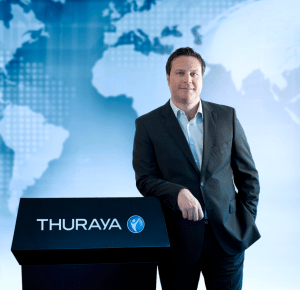Thuraya Ready to Step Up Next Generation Constellation Efforts
[Via Satellite 07-08-2014] Thuraya is stepping up its efforts to commission its next set of satellites, with CEO Samer Halawi telling Via Satellite that the operator expects to issue a Request for Information (RFI) to manufacturers in the next couple of months. “We are focused on this. You can expect an RFI to go out to satellite manufacturers in the next two months. There is a lot of activity going on here,” he said.
The Mobile Satellite Service (MSS) sector has seen a lot of investment in new satellites with the likes of Inmarsat and Iridium investing aggressively in new constellations. Thuraya aims to take a unique approach by starting with a new concept. There are still a number of decisions to be made.
“I don’t know whether we will be in Ka/Ku/L/V band for example. I don’t know. We have not started by looking at the technology. We have started by looking at the concept, and then we have started talking to the manufacturers to see what they can do,” said Halawi. “We have some better ideas of where we are heading, but at this stage, it has not been exactly defined. I am encouraged about the debate going on around satellite innovation. We don’t have a deadline we are working towards in terms of the announcement. What is important for us is that we have a system and a concept that makes real sense.”
Halawi admits the process has proved far from “straightforward.”
“We have been engaging since the start of the year with satellite manufacturers to try and understand the technology of tomorrow, he said. “We have a very good idea on what is the concept. The big question is whether there will be technology there to support that. I am not talking about the technology of today — I am talking about the technology in 2 to 3 years’ time. It is not straightforward, because if it was straightforward, everybody else would do it. We want to take our time to do it.”
Halawi has been leading a transformation of the company’s business as the operator seeks to become a key player in the handheld and portable markets, as well as focusing on high growth regions such as Asia, and verticals such as maritime. The company has seen “dramatic” growth in Asia over the last three years, although it did admittedly start from a low base. But, Asia now accounts for 30 percent of Thuraya’s overall revenues, where as not so long ago, it was virtually zero. The company is seeing growth, notably, in its voice business.
“What is interesting is the growth we are able to generate in the voice market. This was a market that had been declining, but for the last two years we generated growth from voice. We have had a good growth in the first quarter in voice. Asia has been a very good market for us,” said Halawi.
The company is seeing three main engines for growth. According to Halawi, “There are three areas of growth we are following. First, we have our existing business and the growth we are seeing through that, in voice, maritime, and with sectors such as the government sector. The second one is more business development activity like the development with ViaSat of the M2M business. This will be our product and we will be selling this. It is a very capable service. We have been working with TrustComm to provide services to the U.S. government. We want to provide them with more security and capabilities. We expect a lot of growth on that front as well. We have so much opportunity within our core markets. Thirdly, there is the next-gen capability that we are starting to plan for.”
However, while the operator is seeing encouraging signs in its business with new product initiatives such as ‘SatSleeve’ gaining traction, a lot will depend on its next set of satellites, which the operator hopes will catapult it forward as a major force on the MSS landscape. However, much work is still to be done before we know the exact make-up of this new system. There are many intangibles here.
“We are looking at a concept that does not exist today,” said Halawi. “It could be some sort of hybrid system. It does not have to be in GEO (Geostationary Orbit). We are basing the concept on what we think people need, irrespective of the orbit, spectrum band, or other technology related matters.”
